Fermenting Beer with Lallemand LalBrew CBC-1 Yeast
Published: September 18, 2025 at 8:48:39 PM UTC
This article provides practical guidance for brewers using Lallemand LalBrew CBC-1 Yeast. It's suitable for both home brewers and small taproom owners in the United States. This yeast strain is reliable for bottle and cask conditioning. It also works well for primary fermentations of cider, mead, and hard seltzer.
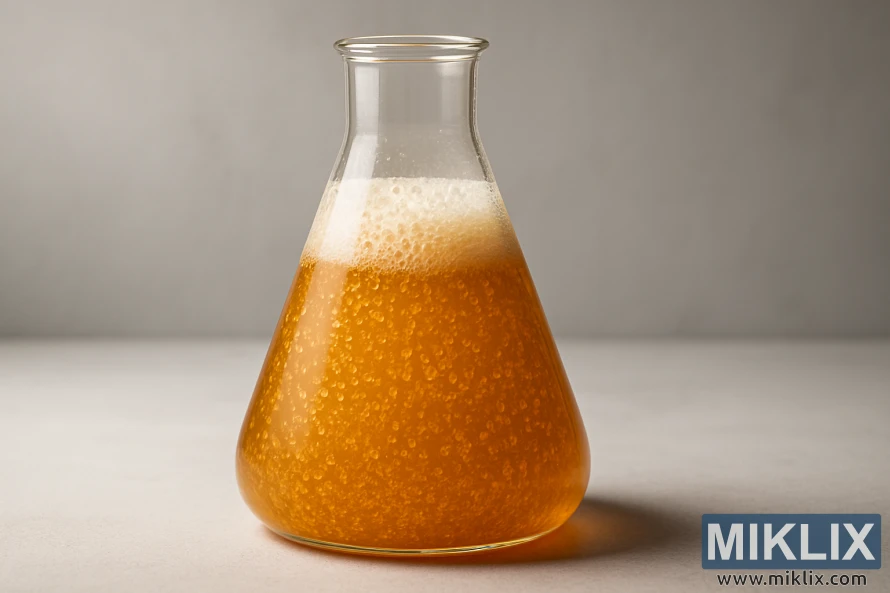
Key Takeaways
- Lallemand LalBrew CBC-1 Yeast excels at CBC-1 bottle conditioning and primary fermentations for light beers and ciders.
- Practical tips on pitching, rehydration, and temperature help avoid stalled or over-attenuated bottles.
- Expect clean attenuation and neutral ester profile when fermenting beer with CBC-1.
- Storage, handling, and sanitation are critical to preserve viability of bottle conditioning yeast.
- This Lallemand CBC-1 review includes comparisons, recipes, and sourcing guidance for brewers.
Overview of Lallemand LalBrew CBC-1 Yeast
LalBrew CBC-1 is a dry strain from Lallemand's extensive culture collection. It's chosen for bottle and cask conditioning due to its high pressure tolerance and alcohol resistance.
As a Saccharomyces cerevisiae CBC-1, it ferments like a top-fermenting yeast but has a neutral profile. The Lallemand yeast profile indicates that CBC-1 doesn't break down maltotriose, preserving malt character.
During refermentation, the yeast forms a tight mat that settles at the bottom of bottles or casks. This characteristic makes clarification easier and helps preserve the beer's original aroma and flavor.
Beyond its use in bottle conditioning, CBC-1 is also suitable for primary fermentation of dry cider, mead, and hard seltzer. It achieves high attenuation on simple sugars with proper nutrition and oxygen management.
- High alcohol and pressure resistance suitable for secondary conditioning.
- Neutral sensory contribution keeps recipe character true.
- Reliable flocculation produces a compact yeast cake.
- Versatile for clean, simple-sugar fermentations with good attenuation.
The Lallemand yeast profile and CBC-1 overview highlight its popularity. Many brewers select it for consistent bottle conditioning and neutral primary ferments that require a clean finish.
Why Choose Lallemand LalBrew CBC-1 Yeast for Bottle Conditioning
Lallemand LalBrew CBC-1 is a top choice for bottle conditioning yeast. It offers consistent priming results, thanks to its high alcohol and carbonation pressure resistance. This makes it perfect for refermentation in sealed containers like bottles and casks.
Its neutral flavor profile is a major advantage. CBC-1 does not ferment maltotriose, which helps preserve the beer’s original aroma and hop character. This is key during bottle conditioning.
Another benefit is its efficient settling behavior after carbonation. The yeast forms a tight mat, reducing yeast in service and speeding up clarification. This results in clearer beer with less sediment in each pour.
- Predictable carbonation: pairs well with simple priming sugars such as dextrose.
- Limited cell division: internal reserves support roughly one cell division in the bottle, enough for carbonation without excess biomass.
- Stress tolerance: handles alcohol and CO2 pressure typical of conditioned bottles.
These advantages make CBC-1 a practical choice for both commercial and home brewers. It ensures flavor integrity and consistent carbonation. Use standard priming rates and simple sugars to maximize CBC-1 benefits while keeping the beer’s intended profile intact.
Key Specifications and Technical Data for CBC-1
Lallemand provides CBC-1 specifications for brewers to select the ideal strain for bottle and cask conditioning. The yeast, Saccharomyces cerevisiae, is a top-fermenting variety. It forms a compact yeast mat after fermentation, thanks to its tight sediment profile.
Typical LalBrew CBC-1 technical data includes percent solids between 93 and 97 percent. Viability is at or above 1 x 10^10 CFU per gram of dry yeast. Microbial purity is strict, with wild yeast and bacterial contaminants below 1 per 10^6 cells. The strain tests negative for diastaticus and phenolic off-flavor (POF).
CBC-1 specifications highlight that this strain is a killer yeast. It secretes killer toxins that can inhibit killer-sensitive strains in mixed cultures. Separate handling and testing are recommended when reusing equipment or yeast.
- Fermentation temp range: optimal 20–30°C (68–86°F), though some retail specs show minimums near 15°C and maximums around 25°C.
- Yeast alcohol tolerance: 12–14% ABV for traditional cask and bottle conditioning.
- Yeast alcohol tolerance in other drinks: tolerance can reach up to 18% ABV in cider, mead, and hard seltzer applications.
Product release includes specification and safety datasheets from Lallemand that detail handling, storage, and confidence in lot consistency. Brewers will find the LalBrew CBC-1 technical data useful for planning pitch rates, conditioning timelines, and packaging decisions.
When comparing CBC-1 specifications to other LalBrew strains, consider viability, yeast alcohol tolerance, and the stated fermentation temp range for best performance in your recipes.
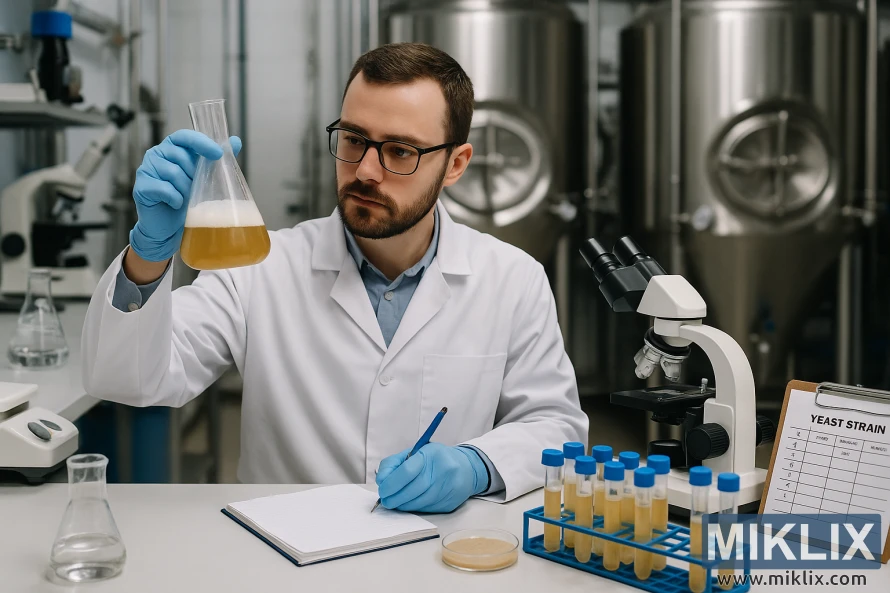
Pitching Rates and Recommended Dosage for Different Applications
When selecting a pitch, consider the final product's purpose. For bottle conditioning, a dosage of 10 g/hL is sufficient. This amount typically completes refermentation in two weeks at optimal temperatures, using simple sugars.
Primary fermentation, on the other hand, requires a more substantial approach. For cider and mead, aim for 50–100 g/hL to foster a steady ferment. Hard seltzer, with its low nutrient musts, benefits from a stronger pitch rate, usually 100–250 g/hL, ensuring a clean fermentation.
High-gravity or stressful ferments necessitate extra attention. In such cases, increase CBC-1 pitching rates and add nutrients. This provides the necessary nitrogen, vitamins, and minerals for robust yeast activity.
Dry yeast from Lallemand does not require aeration before pitching. Yet, nutrient additions are critical for cider, mead, and seltzer recipes. For accurate dosing, measure yeast by weight, avoiding volume or packet counts.
- Bottle conditioning dosage: 10 g/hL for most applications.
- Cider and mead primary pitch: 50–100 g/hL.
- Hard seltzer primary pitch rate for cider mead seltzer: 100–250 g/hL.
The pitch rate significantly impacts fermentation speed and flavor. Lower pitches can slow down fermentation, potentially leaving esters or off-notes. Higher pitches, conversely, promote a brisk, neutral finish. Choose the CBC-1 pitching rates that align with your flavor objectives and the batch's stress level.
Re-pitching CBC-1 in cider, mead, or hard seltzer is not advisable. For optimal results, employ fresh, accurately dosed CBC-1. Adhere to nutrient and temperature guidelines for a reliable fermentation process.
Rehydration vs Dry Pitching Practices
For bottle conditioning, rehydration CBC-1 is the preferred route. Rehydrating yeast before adding it to packaged beer ensures even distribution. This method also lowers the chance of uneven refermentation. To achieve consistent results, measure by weight to target about 10 g/hL.
Follow Lallemand's standard rehydration protocol to avoid stressed cells. Significant deviations can lengthen final conditioning times. They can also produce under-attenuation and raise contamination risk. When in doubt, use lukewarm, sanitized water and allow the yeast to rest per manufacturer instructions.
Dry pitching CBC-1 during bottle conditioning is not recommended. Sprinkling dry yeast into filled bottles or kegs can lead to patchy carbonation. This results in variable taste across a batch. Uneven settling leaves some containers under-carbonated and others over-carbonated.
For primary fermentation of cider, mead, and hard seltzer, dry pitching CBC-1 works well. Sprinkle the yeast evenly over the wort or must as the fermenter fills. This method is simple, consistent, and limits additional handling that might introduce contaminants.
When equipment or workflow prevents proper dry pitching for bottle work, bottle conditioning rehydrate is the safe fallback. If fermentations are stressful, acclimate the rehydrated yeast by adding small volumes of primed beer in steps. This gradual exposure reduces cell shock and helps achieve a reliable final carbonation.
- Rehydrate CBC-1 for bottle conditioning to ensure uniform refermentation.
- Aim for 10 g/hL by weight for typical bottle-conditioning dosages.
- Use dry pitching CBC-1 for primary ferments of cider, mead, or seltzer.
- When needed, bottle conditioning rehydrate with staged additions to reduce stress.
Understanding how to pitch CBC-1 comes down to the application. Match the method to the package: rehydrate for bottles, dry pitch for open primary ferments. This approach keeps carbonation consistent and lowers the chance of off-results.
Fermentation Temperature Management and Timelines
Managing CBC-1 fermentation temperature is key to predictable bottle conditioning and primary fermentations. Lallemand's technical guidance suggests an optimal range of 20–30°C (68–86°F) for best activity with CBC-1. Some retail specs list 15–25°C as a minimum and maximum. Always follow the manufacturer's datasheet for consistent attenuation and aroma profiles.
The refermentation time CBC-1 depends on several factors. These include wort gravity, priming sugar type, pitching rate, and nutrient levels. A standard priming dose of around 10 g/hL of fermentable sugar typically leads to completion in about two weeks at the recommended temperatures. Colder storage slows activity, extending timelines.
Total CBC-1 timelines vary based on application. Primary fermentation may be faster or slower than bottle conditioning. Monitor gravity readings for bulk fermentations and check CO2 pressure or perform gentle sampling in conditioned bottles when safe. Use a calibrated hydrometer or refractometer for reliable measures.
To accelerate stressed or rapid fermentations, increase pitching rates and improve nutrient availability. Small temperature increases within the 20–30°C window can speed yeast metabolism and shorten refermentation time CBC-1. Monitor yeast health closely to avoid off-flavors.
Practical steps to control timing:
- Keep primary and secondary vessels insulated to hold target CBC-1 fermentation temperature.
- Stagger fermenter and bottle conditioning temperatures if you need faster refermentation time CBC-1 without stressing primary yeast.
- Record CBC-1 timelines for each recipe so you can refine pitching rate, nutrients, and temperature for repeatable results.
Good temperature control and consistent monitoring reduce variability and give brewers predictable carbonation levels. Adjust parameters based on measured progress, not fixed days, to ensure safe, stable conditioning.
Flavor and Attenuation Characteristics
Lallemand LalBrew CBC-1 presents a clean, restrained flavor profile. It keeps malt and adjunct flavors in check. As a neutral yeast, it minimizes estery or phenolic aromas during primary fermentation and bottle conditioning of cider, mead, or seltzer.
The strain does not consume maltotriose, preserving the original malt sweetness and body. This means the finished gravity stays closer to the brewer’s target, even with malt extracts present.
With simple sugars like dextrose for carbonation, CBC-1 shows strong attenuation. Proper nutrient additions are key. It ferments glucose and sucrose well, producing reliable CO2 for bottle conditioning while keeping yeast-derived flavors minimal.
Cell reserves in CBC-1 allow for limited cell division in the bottle. Typically, yeast complete about one generation of growth during conditioning. This single generation provides enough biomass for carbonation without excess yeast sediment.
Pitch rate significantly impacts both flavor and attenuation. A low bottle-conditioning pitch rate near 10 g/hL minimizes new biomass. This preserves the beer’s character. Brewers aiming for a very neutral finish should consider this lower dosage for subtlety in mouthfeel and aroma.
- Neutral yeast behavior supports malt-forward recipes.
- attenuation maltotriose preservation maintains original malt notes.
- Strong attenuation on simple sugars ensures consistent carbonation.
Best Practices for Bottle Conditioning with CBC-1
For bottle conditioning, a simple priming sugar like dextrose is recommended for its predictable results. When using CBC-1 priming sugar, it's essential to measure accurately to achieve the desired volumes. Dextrose ensures consistent carbonation and minimizes off-flavors compared to complex syrups.
Accurate yeast dosing is critical. For Lallemand LalBrew CBC-1, a bottle-conditioning dose of 10 g/hL is advised. This dosage strikes a balance between reliable refermentation and a clean sediment that enhances beer clarity.
Before packaging, rehydrate the yeast according to the manufacturer's instructions. Adhering to Lallemand’s rehydrate procedure ensures even cell recovery and distribution. Neglecting or rushing this step can prolong conditioning time and increase contamination risks.
Temperature management during refermentation is key. Aim for a range of 20–30°C (68–86°F) to carbonate the bottles effectively. Stable temperatures not only shorten conditioning time but also ensure consistent carbonation across the batch.
Allow about two weeks at the recommended temperature with 10 g/hL and a standard priming dose for conditioning. The actual time may vary based on temperature, pitch rate, and sugar quantity. It's wise to monitor a few test bottles before labeling the full batch.
Expect a compact yeast pack at the bottle bottom. CBC-1 forms tight sediment, aiding natural clarification. Plan for gentle racking or careful pouring to avoid excess yeast in the served beer.
- Sanitize bottles, caps, and filling tools thoroughly to reduce contamination risk.
- Use measured CBC-1 priming sugar doses to keep carbonation levels consistent.
- Follow the CBC-1 rehydrate procedure when using dry yeast to improve viability.
- Store conditioned bottles at serving temperature for a few days before tasting to allow CO2 integration.
Consult Lallemand’s bottle conditioning best practices for detailed step-by-step guidance when scaling or adjusting recipes. Adhering to these methods will enhance consistency, reduce variability, and help achieve the desired carbonation profile with CBC-1.
Sanitation, Killer Yeast Considerations, and Cross-Contamination Risks
Lallemand’s CBC-1 is a killer yeast strain that secretes proteins to inhibit many brewing strains. This characteristic ensures refermentation remains pure when using a single strain for bottle conditioning. It is essential to note that killer yeast CBC-1 can persist on surfaces and equipment after use.
Cross-contamination yeast issues occur when residual CBC-1 remains in drains, siphons, bottling lines, or racking equipment. Even small amounts can suppress future fermentations with killer-sensitive yeasts. Small breweries and homebrewers are equally vulnerable when switching strains without thorough cleaning.
Implement a strict CBC-1 sanitation protocol. Utilize hot water flushes, a suitable brewery-grade sanitizer, and mechanical scrubbing for fittings and seals. Focus on bottling lines, transfer hoses, and pump seals, as biofilm can conceal cells.
- Rinse equipment immediately after use to remove sugars and trub.
- Soak detachable parts in an approved sanitizer per manufacturer directions.
- Sanitize bottling valves and bottle fillers between batches.
Consider dedicated tools and colors for CBC-1 runs. If separate gear is not feasible, schedule CBC-1 fermentations at the end of a production day or week. This approach minimizes the risk of contaminating the next session with a different strain.
Test finished products through Lallemand’s recommended release checks when using CBC-1 at commercial scale. For smaller setups, maintain records of cleaning cycles and monitor subsequent fermentations for unusual lag or under-attenuation. This may indicate cross-contamination yeast activity.
When in doubt, disassemble complex fittings and inspect for residue. Replace worn gaskets and porous tubing more frequently if you regularly use killer yeast CBC-1. These precautions significantly reduce risk and safeguard the integrity of all future brews.
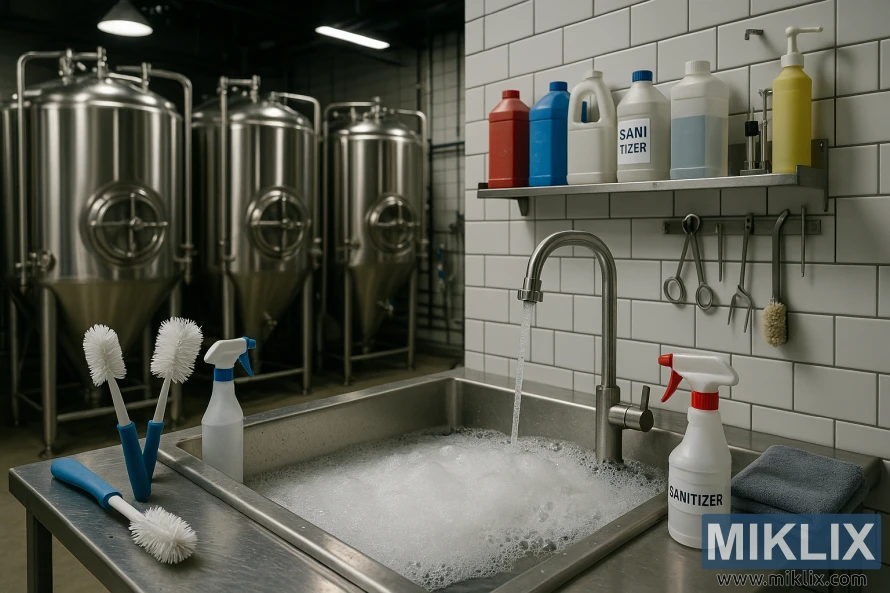
Performance in High-Gravity and Stressful Fermentations
Lallemand LalBrew CBC-1 excels in a variety of beers and bottle conditioning, reaching up to 12–14% ABV. For cask and bottle work, it performs reliably. In cider, mead, and hard seltzer, it can tolerate near 18% ABV with careful management.
High-adjunct, high-sugar, or high-acid mashes stress CBC-1 yeast. These conditions increase the risk of stalled fermentations and off-flavors. Adequate nutrients and preparation are essential to mitigate these risks.
To ensure viability, increase the pitch rate for stress beyond standard recommendations. A higher cell count aids in maintaining healthy fermentation. This approach reduces fusel and sulfur compounds. For cider, mead, or seltzer, use commercial nutrient blends.
- Use fresh packs instead of re-pitched yeast in cider, mead, or seltzer.
- Raise the pitch rate for stress by 25–50% based on gravity and adjunct load.
- Include yeast nutrients and manage oxygen early in fermentation.
When acclimating CBC-1 for high-gravity beers, employ a gradual exposure strategy. Gradually add wort or primed beer to acclimate cells. This method minimizes osmotic shock and enhances viability during critical early hours.
Re-pitching CBC-1 into cider, mead, or hard seltzer is not advisable. Start with a fresh, appropriately sized pitch to meet stress demands. Use validated pitch calculators and adjust for sugar content, target ABV, and desired attenuation.
Monitor gravity, temperature, and sensory cues closely in stressful fermentation CBC-1 batches. If fermentation stalls or off-flavors appear, consider nutrient boosts, gentle aeration early on, and controlled temperature adjustments. These actions help keep yeast metabolically active without further stressing them.
With the right pitch rate for stress, nutrient management, and acclimation, CBC-1 high gravity fermentations can achieve target alcohols with clean profiles. Careful planning ensures consistent bottle conditioning results, even under demanding conditions.
Storage, Shelf Life, and Handling to Preserve Viability
Store LalBrew CBC-1 in its original vacuum-sealed packaging in a dry place below 4°C (39°F). Proper CBC-1 storage preserves cell viability and keeps performance within the printed expiry date.
Do not use packs that have lost their vacuum. CBC-1 rapidly loses activity when exposed to air. Opened packs must be re-sealed and returned to cold storage immediately.
If you reseal a pack under vacuum right after opening, keep it below 4°C until the printed expiry date. If you cannot re-vacuum, use the opened pack within three days for best results.
Follow Lallemand yeast shelf life guidance: performance is guaranteed when the product is stored correctly before expiry. Lallemand dry brewing yeast tolerates short, occasional lapses in conditions but performs best with consistent cold, dry storage.
- Keep yeast away from heat sources and direct sunlight.
- Do not store in damp or humid areas that can compromise packaging.
- Write the date you open each pack to track the three-day window if not re-vacuumed.
Proper handling reduces the risk of lost viability and inconsistent fermentations. For clarity on how to store CBC-1, follow the cold, dry, and vacuum guidance on each packet.
Comparing CBC-1 to Other Bottle Conditioning and Brewing Strains
LalBrew CBC-1 excels in bottle conditioning yeast comparisons due to its high alcohol and pressure tolerance. It preserves the hop and malt flavors, leaving a neutral taste. This yeast does not ferment maltotriose, ensuring residual sweetness and body from primary fermentation.
In primary fermentation, brewers often prefer standard ale yeasts like Wyeast 1056 or Safale US-05. These strains ferment maltotriose, leading to a drier finish. CBC-1, on the other hand, is best suited for refermentation in bottles and casks.
For packaged products, CBC-1's ability to settle as a tight mat is advantageous. Low-dose additions, typically 10 g/hL, help maintain a clean beer. This is a plus compared to generic strains that can cause haze or off-flavors.
In cider, mead, and hard seltzer, CBC-1 competes with neutral, high-attenuating strains like Lalvin EC-1118. Its neutral profile and strong attenuation on simple sugars make it ideal for clean fermentation.
As a killer yeast, CBC-1 provides protection in single-strain refermentation. It suppresses wild Saccharomyces during bottle conditioning. This requires strict sanitation to avoid complications in mixed-culture programs and cross-contamination.
- Primary beer fermentation: favor ale strains that consume maltotriose over CBC-1 for full attenuation.
- Bottle conditioning: CBC-1’s low-dose profile and tight settling make it a top candidate in bottle conditioning yeast comparison.
- Cider/mead/seltzer: CBC-1 holds its own versus neutral high-attenuating strains.
Brewers should align strain choice with their desired outcome. CBC-1 is ideal for neutral flavor, reliable refermentation, and clean settling. For complete primary attenuation and mixed-culture projects, choose maltotriose-fermenting ale strains.
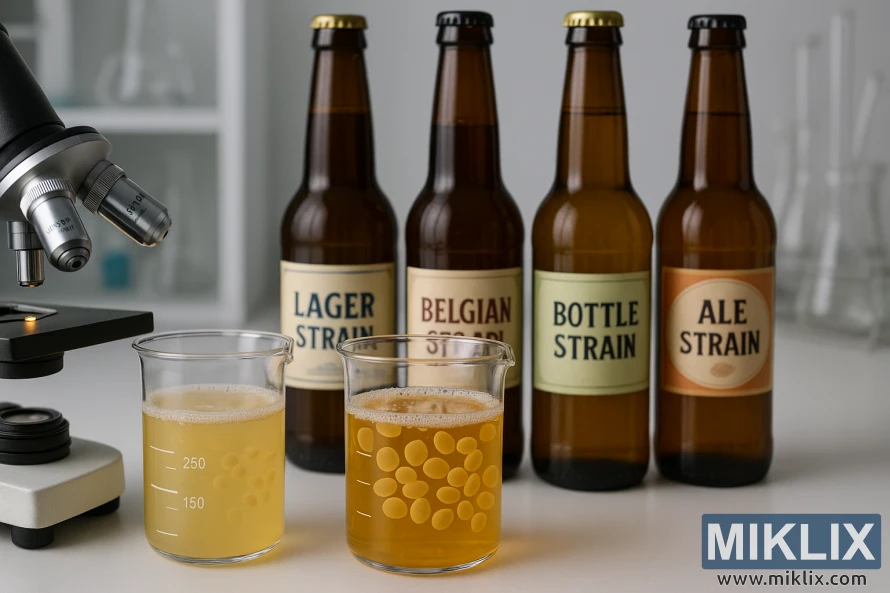
Practical Recipe Example and Step-by-Step Bottle Conditioning Workflow
This CBC-1 bottle conditioning recipe is for a 20 L (5.3 gal) pale ale. The goal is to achieve 2.3 volumes of CO2. For 5.3 gal, use 4.5 oz (128 g) of dextrose, adjusting for beer temperature and residual CO2.
For 20 L (0.2 hL), use about 2 g of Lallemand LalBrew CBC-1. Scale the weight to match your batch volume for accurate dosing.
- Confirm final gravity and beer temperature, then calculate the required priming sugar for the desired volumes. This step determines the exact priming sugar CBC-1 needs to reach 2.3 volumes.
- If equipment allows, rehydrate CBC-1 per Lallemand instructions and weigh the yeast to reach 10 g/hL. If not, follow recommended rehydration or dosing steps to ensure even distribution.
- Sanitize all bottling equipment thoroughly to avoid contamination. Pay particular attention to killer strain controls to prevent cross-contamination with other cultures.
- Dissolve priming sugar in boiled water, cool, and mix with beer in a sanitized bottling bucket to ensure even distribution of priming sugar CBC-1 will ferment.
- Add rehydrated CBC-1 to the primed beer and gently mix. Aim for uniform yeast suspension without aerating the beer.
- Fill sanitized bottles and cap them. Store bottles at 20–30°C (68–86°F) for about two weeks while checking carbonation progress.
- Chill a sample bottle and test carbonation. If under-carbonated, allow additional conditioning time at the recommended temperature.
- Note sediment behavior: CBC-1 tends to settle into a tight mat at the bottle bottom. Pour carefully to minimize yeast in the served beer.
This step-by-step guide shows how to bottle condition with CBC-1 cleanly and predictably. It covers priming calculations, rehydration, sanitation, and storage to maximize consistent carbonation.
Keep records of temperature, priming sugar CBC-1 weight, and sample results. Tracking these variables helps fine-tune future runs and improves repeatability of your CBC-1 bottle conditioning recipe.
Troubleshooting Common Issues with CBC-1 Fermentations
Slow or stalled refermentation often stems from a few common causes. First, check the pitch rate, rehydration steps, and the storage date of the Lallemand package. Bottles stored too cold can stop fermentation. Low nutrients impact cider, mead, and seltzer more than beer. Poor viability from old or vacuum-broken packs can lead to CBC-1 stuck fermentation.
When you encounter CBC-1 stuck fermentation, try these remedies in order.
- Confirm packaging vacuum and expiry date. A compromised pack can mean dead yeast.
- Bring bottles to the recommended conditioning temperature range and keep them steady.
- Verify priming sugar was mixed correctly so yeast has fuel to carbonate.
- For extreme cases, add a small dose of a fresh ale yeast. Note that re-pitching CBC-1 into some products is not advised.
Under-carbonation after the expected conditioning window points to temperature and yeast factors. Store bottles at 20–30°C for a typical two-week finish. Allow extra time before changing your process. Confirm both priming sugar amount and yeast viability before reworking a batch.
Bottle conditioning problems that manifest as off-flavors usually come from sanitation lapses or rehydration mistakes. CBC-1 is POF negative and diastaticus negative, which reduces certain risks, but contamination can occur. Reinforce sanitation routines and follow Lallemand rehydration protocols exactly.
If you pour and see too much yeast in the glass, check dosing. The recommended target is about 10 g/hL. Give the yeast mat time to settle before serving. When pouring, leave the last ounce in the bottle to avoid yeast in the glass.
Cross-strain inhibition shows up when later batches underperform after using CBC-1 earlier. Residual cells on kegs, bottles, or lines can carry over. Perform deep cleaning and sanitize equipment thoroughly to prevent future bottle conditioning problems and cross-contamination.
Where to Buy, Pricing and Sizing Options in the United States
Discover Lallemand LalBrew CBC-1 through various U.S. channels. Visit Lallemand’s USA site, authorized brewing suppliers, homebrew shops, and larger distributors for the latest stock. This is where you can purchase Lallemand CBC-1 USA.
Retailers offer CBC-1 in various pack sizes for both home and commercial use. You'll find single-use 11 g retail packs and larger 500 g commercial packs. It's important to check the CBC-1 pack sizes before ordering to ensure they fit your batch size and storage.
The CBC-1 price can vary based on vendor and pack weight. For example, a 500 g pack is listed around $212.70 CAD in North America. Prices in USD may differ; always check local listings for the current CBC-1 price in the United States.
When placing an order, confirm the shipping terms, taxes, and whether the seller uses cold or dry storage. Product pages may redirect to country-specific stores. Always verify the final costs and delivery options before making your purchase of Lallemand CBC-1 USA.
- Confirm vacuum integrity and expiry date on arrival.
- Do not use packs that have lost vacuum or show signs of damage.
For large or repeated purchases, compare distributors for bulk pricing, lead times, and available CBC-1 pack sizes. This comparison helps manage costs and ensures the CBC-1 price aligns with your brewing schedule and storage requirements.
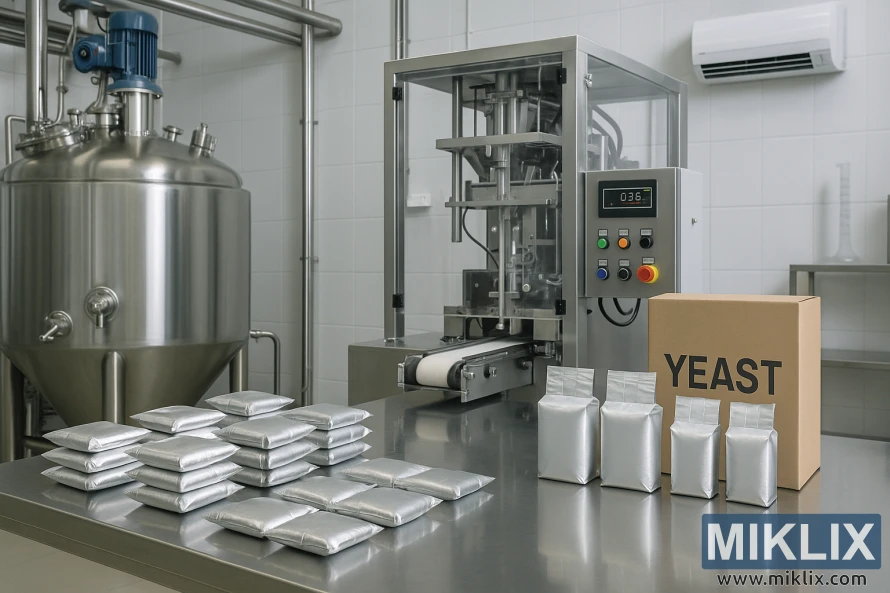
Conclusion
This CBC-1 summary emphasizes LalBrew CBC-1 as a specialized tool for bottle and cask conditioning. It boasts a neutral flavor profile, high alcohol tolerance, and robust pressure resistance. Its performance on simple sugars is consistent, ensuring clear pours and preserving the beer's original character.
For those in small breweries or U.S. homebrewers pondering whether to use CBC-1, the decision hinges on your priorities. If you seek a strain that excels in low-dose, pressure-resistant applications for bottle conditioning, cider, mead, or hard seltzer, CBC-1 is a prime candidate. Just remember to provide necessary nutrients. Adhere to Lallemand’s rehydration instructions, store it coolly under 4°C, and be mindful of its killer yeast nature to prevent contamination.
In conclusion, this Lallemand CBC-1 review affirms that, when employed at the recommended pitching rates, with precise temperature management and rigorous sanitation, CBC-1 guarantees consistent, neutral outcomes. It stands as a reliable choice for brewers desiring predictable results and minimal flavor alteration during the conditioning process.
Further Reading
If you enjoyed this post, you may also like these suggestions:
- Fermenting Beer with White Labs WLP833 German Bock Lager Yeast
- Fermenting Beer with White Labs WLP500 Monastery Ale Yeast
- Fermenting Beer with Mangrove Jack's M54 Californian Lager Yeast
